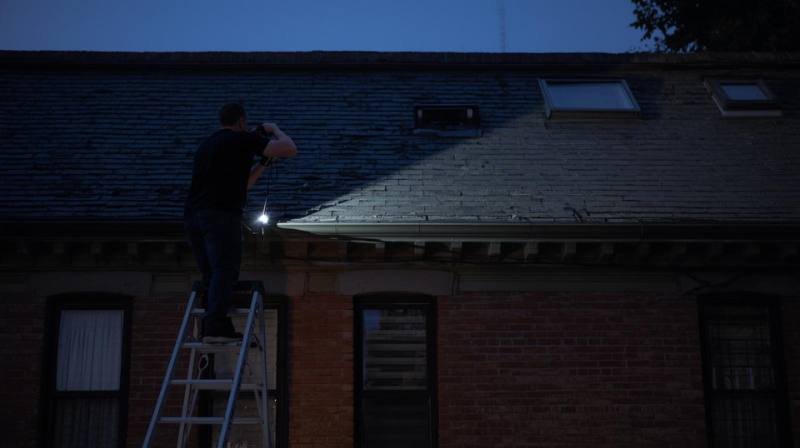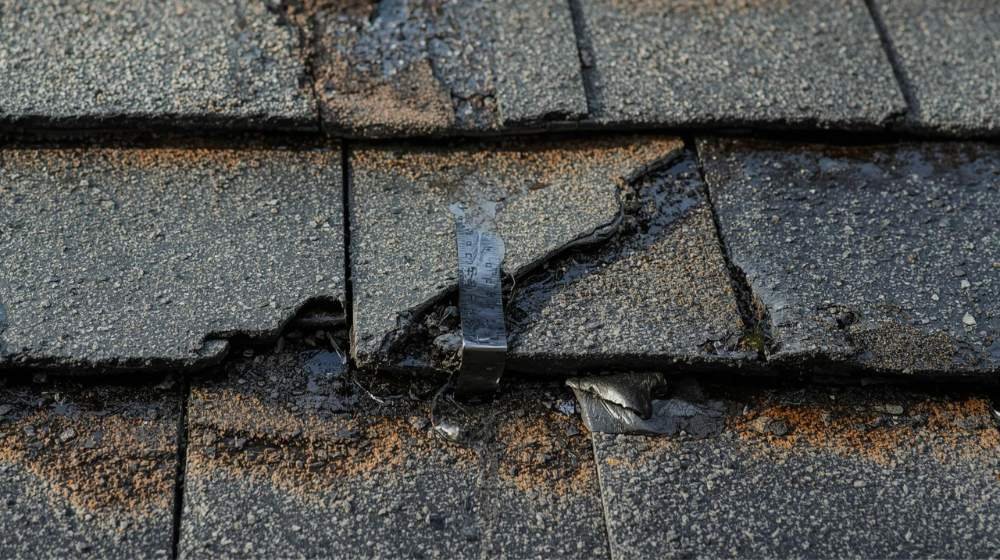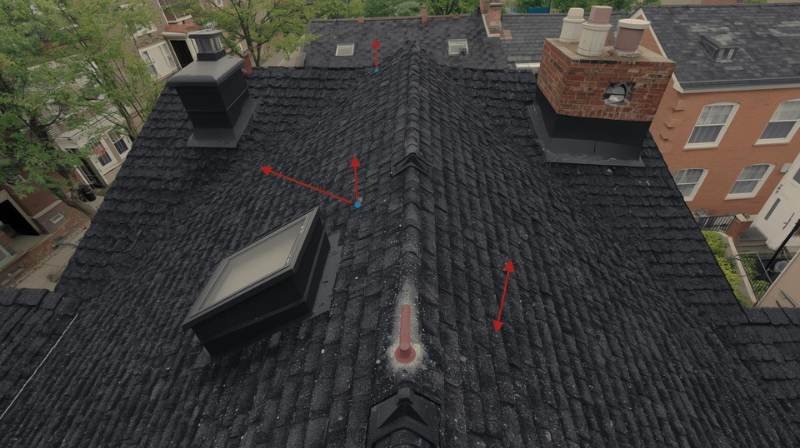
Wait, is your roof leaking? If you’ve noticed water stains or damp spots inside your home, it might be a sign of a roof leak. Don’t worry, roof leaks are common, especially in places like Brooklyn, NYC. However, before you jump to conclusions, it’s essential to understand how to identify and resolve the issue.
In this guide, we’ll show you how to spot roof leaks, repair them, and prevent future problems. We have some basic suggestions to help you take charge of the problem and keep your roof in good condition, whether it’s a minor issue or something more serious.
Quick View of Key Information
- Roof leaks are common: Water stains or damp spots may signal a leak, especially in Brooklyn, NYC.
- False leaks can occur: Water may appear to be leaking from the roof, but it could actually be coming from plumbing or windows.
- Do a visual check: Look for missing shingles or damaged flashing.
- Inspect the attic for moisture: Check for dampness, water stains, or signs of mold.
- Use a hose to locate leaks: Spray sections of the roof and observe for water accumulation inside.
- Clean gutters regularly: Blocked gutters can cause leaks.
- Check roof valleys and slopes: Ensure low spots are sealed to prevent water pooling.
- Seal gaps around flashing: Fix leaks around vents or chimneys.
- Use caulk for temporary fixes: Seal small cracks until a permanent repair is done.
- Call a pro if needed: Contact a roofer if you can’t find the leak or if it’s serious.
What is a False Roof Leak?
A false roof leak occurs when it appears that your roof is leaking, but the source of the water is actually coming from somewhere else. It could be caused by plumbing issues, leaking windows, or even condensation in the attic. These leaks can be misleading because they often appear as water stains on ceilings or walls, which may lead you to believe the roof is to blame.
False leaks are tricky to identify, but knowing the signs can help you avoid unnecessary repairs. If you’re unsure whether your leak is real or false, it’s always best to have an expert inspect your home.
10 Effective Strategies to Find Roof Leaks
It’s not always easy to find a leak in the roof. The trick is to methodically search for potential causes, whether from the roof itself or elsewhere. With these 10 strategies, you can effectively locate the source of your leak and understand what’s going wrong with your roof. Let’s get started!
- Start with a visual inspection: Begin by examining the exterior of your roof. Look for damaged or missing shingles, cracked flashing, or any other visible signs of wear. Even small problems can let water in, so make sure you inspect every corner. Take your time to walk around and visually inspect the condition of your roof.
- Check your attic or ceiling for moisture: Go into your attic or the ceiling space directly above your roof. Look for signs of dampness, water stains, or mold—indicators that water has already made its way inside. A flashlight can help you spot leaks in darker areas. It’s important to act quickly, as the longer moisture remains, the more damage it can cause.
- Inspect roof penetrations (vents, chimneys, skylights): Roof vents, chimneys, and skylights are common areas where leaks can occur. If the seals or flashing around them are damaged, water can seep in. Ensure these areas are tightly sealed and inspect for any gaps. Sealing these spots can often prevent future leaks.
- Use a garden hose to simulate rain: If you can’t visually see the leak, you can use a hose to help locate it. Start at the bottom of the roof and work your way up, spraying small sections at a time. Have someone inside your home watch for any signs of water entry. This method will help you pinpoint the exact location of the leak.
- Check your gutters and downspouts: Clogged gutters and downspouts can cause water to back up and eventually leak into your home. Regularly clean these out to ensure water flows off the roof properly. Blocked gutters can also damage your roof over time, so it’s best to stay on top of this maintenance.
- Look for rust or moss on the roof: Rust spots or moss growth on your roof may indicate trapped moisture. These areas can wear down roofing materials and cause leaks. Moss, in particular, can lift shingles, allowing water to enter. Remove moss and treat rust to prevent further damage.
- Check for gaps around flashing: Flashing around chimneys, vents, and other roof penetrations can crack or pull away, letting water seep in. Inspect these areas carefully for any gaps or deterioration. Replacing or resealing damaged flashing is a simple fix that can prevent major leaks.
- Check the roof slope and valleys: Water tends to gather in low spots, or roof valleys, where shingles or tiles meet. Make sure these areas are properly sealed and that no debris is blocking the water’s flow. Water pooling in valleys can lead to serious leaks if not addressed.
- Inspect the ridge cap and shingles: Over time, ridge caps can become loose or damaged, and shingles can crack or break. This is particularly common in older roofs. If you find any damaged shingles, replace them promptly to avoid water penetration. The ridge cap should also be checked to ensure a tight seal.
- Call a professional if needed: If you’re still unable to locate the leak, or if the problem seems more complicated, it’s a good idea to call a professional roofer. They have the tools and expertise to find hard-to-spot leaks. It’s better to have a trained eye assess your roof than to miss a potential issue that could lead to bigger problems.

How to Repair Roof Leaks
It’s important to repair roof leaks promptly to prevent further damage to your property over time. Fixing a small issue or a major leak right away might save you time and money in the long run. Here are 7 methods you can use to fix roof leaks on your own or with the help of a professional.
- Seal cracks with roofing caulk: If you spot a small crack or gap in your roof, applying a roofing caulk is a simple and effective fix. Clean the area around the crack to ensure the caulk sticks properly. Once applied, it will create a waterproof seal that can stop the leak. This is a great temporary fix until you can perform a more permanent repair.
- Replace damaged shingles: Missing or damaged shingles are often the cause of leaks. To fix this, carefully remove the damaged shingles and replace them with new ones. Ensure the new shingles match the existing shingles on your roof. You can nail the new shingles in place and use roofing sealant around the edges to create a watertight seal.
- Repair flashing around roof penetrations: Flashing that is loose, cracked, or missing can allow water to seep under your shingles. To repair flashing, you’ll need to lift the shingles around the flashing and reseal it with new caulk or roofing cement. If the flashing is severely damaged, replacing it entirely may be necessary.
- Use a roof patch for larger holes: For larger holes or cracks in your roof, a roof patch can be a lifesaver. This patch is made from durable, waterproof material that can cover the damaged area. Simply apply the patch over the hole and secure it with roofing nails or adhesive. Ensure the edges are sealed to prevent water from seeping under the patch.
- Clear debris from roof valleys and gutters: Clogged valleys or gutters can prevent water from flowing off your roof, causing leaks. Remove any debris, such as leaves, branches, or dirt, from these areas. This will allow water to flow freely off the roof and prevent pooling that could lead to leaks.
- Replace or repair roof vents and skylights: If the leak is coming from a vent or skylight, check the seals and flashing around these areas. If the seals are worn out, replace them with new ones. You can also apply caulk to help seal gaps. This will prevent water from seeping in around these roof penetrations.
- Consider re-roofing if damage is extensive: If your roof has widespread damage and repairs are no longer effective, it may be time for a full roof replacement. Re-roofing can be costly, but it’s worth it if your roof is old or extensively damaged. It’s always better to replace a roof when repairs no longer suffice, as it ensures the integrity of your home.

What to Do When You Find a Potential Leak Source
If you find a potential leak source, the first thing you should do is mark the area clearly so you can easily locate it later. Next, stop any water from entering your home by temporarily sealing the area with a tarp or waterproof covering. Take photos of the damage for insurance purposes and to document it for a professional if needed. Ensure that you check the area below the leak for any signs of water damage, mold, or insulation issues. Finally, contact a roofing expert to assess the situation and suggest the best solution for permanent repair.
How to Find a Roof Leak from the Outside
It takes some time and careful attention to find a roof leak from the outside. By carefully inspecting your roof and surrounding areas, you can often locate the source of the problem. Here’s how to do it step-by-step:
- Examine the roof for visible damage: Walk around your house and check for any obvious issues such as missing or damaged shingles, cracked tiles, or broken flashing. Pay special attention to areas where water tends to accumulate, such as valleys or low-lying spots. This can give you an idea of where the water might be entering.
- Inspect roof penetrations (vents, chimneys, skylights): Check areas around chimneys, vents, and skylights, as these are common places for leaks to develop. Look for gaps in the flashing or signs of wear and tear. Even small cracks around these penetrations can lead to leaks over time.
- Look for moss, rust, or algae growth: Moss or algae on the roof can trap moisture, which may eventually lead to leaks. Rusted areas on metal roofing are also a sign that water has been seeping in. If you spot either of these, consider it a potential source of the leak.
- Check for clogged gutters and downspouts: Blocked gutters can cause water to back up and pool on the roof, eventually seeping inside. Clear gutters of leaves and debris, and make sure downspouts are directing water away from the foundation. Proper drainage will help prevent leaks from forming.
- Use binoculars for a closer look: If you can’t safely access the roof, use binoculars to zoom in on hard-to-reach areas. This allows you to spot potential issues like cracked flashing or damaged shingles without needing to climb up. It’s a great tool for identifying the problem from the ground.
How to Identify Leak Location
Identifying the exact location of a roof leak begins by tracing the path of the water inside your home. Look for water stains or damp spots on ceilings and walls directly below the roof. Once you identify the area where water is entering, check the roof above it for visible damage, such as missing shingles or cracked flashing. Remember, leaks may travel along beams or insulation, so the source may not always be directly above the stain.

What Are the Most Common Signs of a Roof Leak?
A roof leak may not always be immediately apparent, but there are several common signs that can indicate a problem. If you notice any of these, it’s a good idea to investigate further or call a professional to prevent further damage.
- Water stains on ceilings or walls: One of the most obvious signs of a leak is the appearance of water stains on your ceilings or walls. These stains are usually brownish in color and can indicate that water is seeping in through the roof. The stains often spread over time, so it’s best to act quickly.
- Mold or mildew growth: Mold and mildew thrive in moist environments, and if you spot them inside your home, it could mean that there’s ongoing moisture from a leak. Mold can spread rapidly and negatively impact indoor air quality, making it a serious issue to address. If you find mold, it’s crucial to locate and fix the leak immediately.
- Peeling or bubbling paint: Paint on walls or ceilings that is bubbling or peeling can be a sign of water intrusion. Water behind the paint causes the surface to weaken, leading to a bubbling or peeling effect. This could mean that water has been sitting in that area for a while, so it’s essential to identify the source.
- Dripping water or puddles indoors: If you notice water dripping or pooling inside your home, it’s a clear indication of a leak. Sometimes, the water may drip intermittently or only during heavy rainfall. Regardless of the timing, it’s important to address this immediately to avoid significant water damage.
- Damp or sagging insulation in the attic: Check your attic for wet or sagging insulation, as this can indicate that water is leaking through the roof. When insulation becomes wet, it loses its ability to function properly, which can result in higher energy bills. Fixing the leak and replacing the insulation is important for energy efficiency.
- Visible daylight through roof boards: If you can see sunlight peeking through the roof boards while in the attic, it’s a clear sign of a roof hole or crack. Even small gaps can allow rainwater to get in, leading to leaks. If you spot daylight coming through, it’s essential to repair the gap before it causes further damage.
How to Prevent Roof Leaks Before They Start
It’s considerably easier and less expensive to prevent roof leaks than to repair the damage after they occur. By taking a few simple steps to maintain your roof, you can protect your home from water damage and extend the roof’s lifespan. Here are some ways to prevent roof leaks before they even start:
- Schedule regular roof inspections: It’s important to inspect your roof at least once a year, especially after harsh weather conditions. Look for missing shingles, cracked flashing, or areas where water could seep through. Catching small issues early can prevent them from becoming major problems.
- Clean gutters and downspouts regularly: Clogged gutters prevent water from flowing off your roof, which can lead to pooling and leaks. Make sure to clean your gutters every fall and spring, and check them after heavy storms. Clear gutters allow water to flow freely, keeping your roof and home safe and dry.
- Trim overhanging tree branches: Trees that are too close to your roof can cause damage by scraping against shingles or blocking gutters. Trim branches regularly to prevent them from causing unnecessary wear and tear. Keeping trees at a distance also reduces the risk of fallen branches during storms.
- Install proper attic ventilation: Poor attic ventilation can lead to trapped moisture, which causes mold, rot, and leaks. Ensure that your attic has proper airflow to keep it dry. Installing vents or using an attic fan can help maintain a healthy environment for your roof.
- Use high-quality roofing materials: Investing in high-quality roofing materials like durable shingles or metal roofing can help prevent leaks. These materials last longer and provide better protection against the elements. Choosing the right materials for your local climate will help ensure your roof can withstand rain, wind, and snow.
- Seal around roof penetrations: Areas where vents, chimneys, or skylights meet the roof are vulnerable to leaks if the seals degrade over time. Inspect these areas regularly and reseal them as needed. Properly sealed roof penetrations will prevent water from seeping through.
- Maintain proper roof slope and drainage: Ensure your roof has the correct slope to allow water to drain efficiently. Flat or low-slope roofs are more prone to leaks because water can pool. If you have a flat roof, ensure it’s properly maintained to prevent water from getting trapped and flowing off.

Why should you choose a professional roofing contractor?
Are you looking for an expert roofing contractor in Brooklyn, NYC? SR General Construction has you covered! Our business is located at 8807 Avenue B, Brooklyn, NY 11236, United States, in the Canarsie area.
We proudly serve all areas of Brooklyn with high-quality, durable roofing solutions. From new installations to repairs and maintenance, we provide the best service at affordable prices. Contact us and experience why we’re Brooklyn’s roofing experts!
FAQ
1. What are the most common causes of roof leaks?
Common causes include damaged or missing shingles, cracked flashing, clogged gutters, and deteriorated pipe boots. These issues allow water to penetrate the roof, which leads to leaks.
2. How can I tell if my roof is leaking?
Signs of a roof leak include water stains on ceilings or walls, damp or sagging insulation in the attic, and visible daylight through roof boards. If you notice any of these, it’s time to inspect your roof.
3. Can I fix a roof leak myself?
Minor leaks, such as replacing missing shingles or sealing small cracks, can be repaired by homeowners with the right tools and safety precautions. However, for extensive damage or if you’re unsure, it’s best to consult a professional.
4. How much does it cost to repair a roof leak?
Repair costs range from $400 to $2,500, depending on the severity of the leak and the type of roof. Minor repairs may cost around $250, while major repairs can exceed $14,000.
5. What should I do if I notice a roof leak?
First, contain the leak by placing a bucket under the drip. Then, assess the damage and consider temporary sealing. Finally, contact a professional roofer for a thorough inspection and repair.
6. How often should I inspect my roof?
It’s recommended to inspect your roof at least twice a year, preferably in spring and fall, and after major storms. Regular inspections help identify potential issues before they become serious problems.
7. Can heavy rain cause roof leaks?
Yes, heavy rain can exacerbate existing roof issues, such as damaged shingles or clogged gutters, which can lead to leaks. Proper maintenance can help mitigate this risk.
